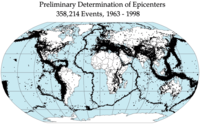
Photo from wikipedia
Due to the increase in greenhouse gas emissions by combustion of fossil fuels, new alternatives for obtaining clean energy have been investigated. In this work, a wild microalgae consortium, grown… Click to show full abstract
Due to the increase in greenhouse gas emissions by combustion of fossil fuels, new alternatives for obtaining clean energy have been investigated. In this work, a wild microalgae consortium, grown in treated wastewater, was used to produce bio-oil by catalytic solvent liquefaction process. Tetralin and zeolite HZSM-5 (Si/Al = 80) were employed as a reaction medium and catalyst, respectively. The effect of H 2 pressure and reaction time on biocrude yield, conversion of biomolecules, and the type of generated chemical compounds in the bio-oil were investigated, and reaction schemes were proposed. The best reaction condition was at 120 min and 760 psi, where a bio-oil yield of 51 wt% was obtained and high percentage of the original protein content was converted. The main type of compounds in the produced bio-oil were oxygenated (~ 50 chromatographic area %) and nitrogenated (~ 18 area %) compounds. H 2 pressure is an important variable to process proteins, lipids, and simple carbohydrates. Despite the high protein content in the feedstock, a relatively low nitrogen content of 1.2–1.5 wt% was found in the resultant bio-oil, which has an estimated HHV of 32–33 MJ/kg.
Journal Title: Biomass Conversion and Biorefinery
Year Published: 2020
Link to full text (if available)
Share on Social Media: Sign Up to like & get
recommendations!